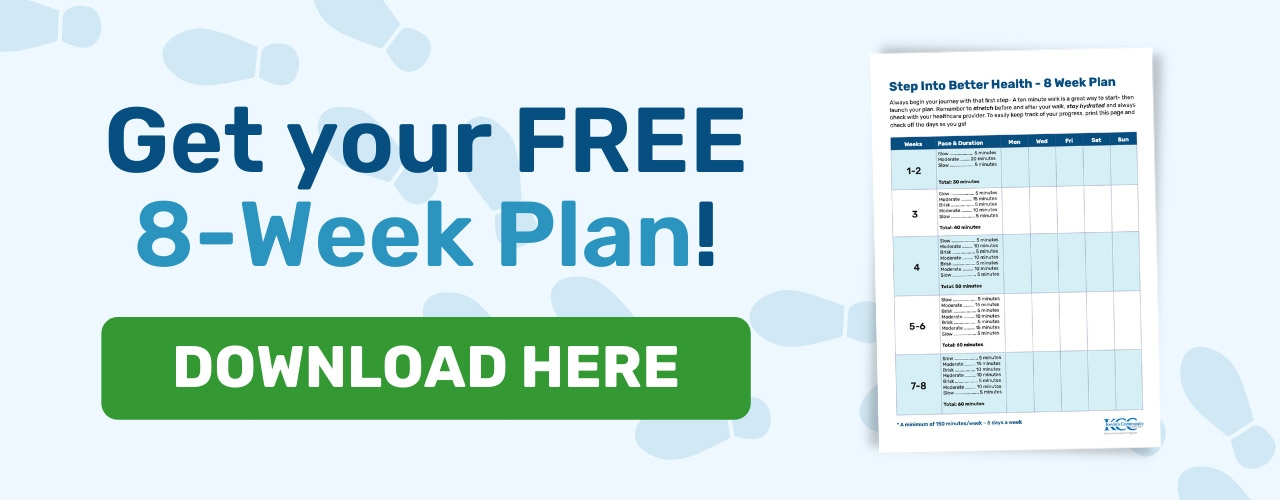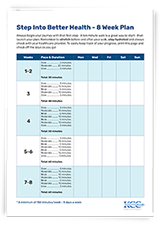Time for self-care- Starting with Fitness
As the seasons change and our attention turns to the changes, around us, it is time to pay attention to the overlooked area of self-care. Let’s start with our fitness. Like so many, I have heard from those who found the COVID quarantines and isolation left them with unanticipated sedentary changes that have resulted in weight gain, achy joints, and unhealthy diets. I am offering some simple tips and hints to help you get started if weight management or weight loss are what you are seeking. Not all of these tips will work for everyone, some will be better than others, but if we begin on this journey and add ideas as we can, I am sure we will make improvements in how we feel and how we look.
This isn’t about a short-term diet or a gimmicky plan. It is about small changes that we can add or subtract from our day-to-day lives to begin to maintain weight, manage weight, or lose some weight.
This plan includes healthy eating, regular physical activity, and balancing the calories you consume with the calories your body uses. For example-the recommended 150 minutes of physical activity per week breaks down into 30 minutes per day for 5 days a week. That 30 minutes /day can be broken down into 10-minute mini walks throughout the day, if 30 minutes at one time is unrealistic.
If we start with just that much we can add on later…
This all comes down to math
You must burn more calories than you eat to lose weight. It is simple enough if you are physically active and portions are under control. The amount that you eat at meals — and how much you snack in between will have a tremendous impact on your success because if you do not monitor this you run the risk of overeating. I hope that you will find the following tips helpful in your quest for weight management and weight loss.
Get most of your calories before noon.
Studies find that the more you eat in the morning, the less you’ll eat in the evening. And if you consume more of your healthy daily calorie allotment early in the day, you have more opportunities to burn off those early-day calories than you would at dinner time. It is optimal for weight loss to have fewer calories in the afternoon and early evening because there is less time to burn off what you consume.
Portion control
The “Nutrition Facts” chart that you will find on most food packaging is a helpful guide for the correct portion serving size and what the nutritional and caloric values are concerning that portion. If the package says – serving size – 2, there will be 2 portions and the calories are based on the individual serving, not the package. If you eat the entire package, you must double the calories, because you ate two portions.
The size of a dinner plate has been enlarged over the years. In the 1960s the standard dinner plate was 10.5”, now the same plate is 11-12”. Portions have increased by 25% in restaurants and homes and so have waistlines.
People will eat what is in front of them, although they may feel full on much less. Order the smallest portions (which used to be the normal size) wherever you are, order the smallest portions possible and drink a glass of water. Next time you go out, eat half your meal, save half the calories. and wrap the remaining half for the next day. https://www.everydayhealth.com/diet-pictures/secrets-to-portion-control.aspx
No need for extra food
Put away the food that is not being served at a meal. You’ll be less tempted by a second helping if you have to take food out again. All food should be in cupboards or refrigerated so nothing is available for grazing.
Slow down- be present
Rushing through your meals is not only bad for your physical health but also your emotional health. Take a few moments to concentrate on healthy eating and enjoy your food.
Monitor your meal plan throughout the day, so you consume more healthy calories early in the day with healthy snacks staggered between breakfast and lunch, and lunch and dinner to avoid a blood sugar crash. Extreme hunger can lead to bad choices and unhealthy eating.
Do not eat while doing something else, such as watching TV or working on your computer. If you aren’t paying attention, it’s more likely you’ll overeat.
If it is hard to find time to go for the 30-minute walk, take a different view
It doesn’t have to be all or nothing. But how often do we fall into that trap? Did you know that mini-walks do you good; mentally, physically and your waist will thank you. Walk five minutes at least every two hours to suppress your appetite and prevent the boredom which can lead to snacking, as well as giving your brain and circulation a boost. The five-minute walks every two hours accumulate for a bonus of an extra 20-minutes of physical activity by the end of the day.
In addition, the CDC has suggested that spending 10 minutes of climbing up and downstairs during the day, as part of a healthy meal and exercise plan will translate into as much as 10 pounds lost over the year.
Did you know that the color of your kitchen can impact your waistline?
Did you know there is research indicating that the colors red, yellow, and orange tend to boost appetite and that the color blue suppresses appetites? Keep that in mind when you are choosing the color palette for your kitchen and dining areas. Try to choose blue linens and serving pieces while you are on a weight-reduction plan.
After breakfast, stick to water.
Breakfast is just what the name says, it breaks your fast from the night before. Don’t eat late and no snacking, so your body can fast during your sleep. Breakfast should be healthy and balanced. Juice, coffee, tea are all excellent choices, but after breakfast, stick with water. The average American consumes an extra 245 calories a day from soft drinks, which translates to nearly 90,000 calories a year—or 25 pounds!
Drink Water
According to accesshealth.org, staying hydrated has numerous health benefits including promoting weight loss, suppressing appetite, improving skin tone, flushing out toxins, increasing energy, relieving fatigue, and improving focus.
It is recommended that we drink 8oz of a non-caloric beverage, preferably clean freshwater each hour to maintain full hydration. Alcohol, soda, and juice contain sugars that contribute to unwanted weight gain. It is important to eliminate beverages that contain sugars and sugar substitutes in your quest for weight loss or weight management. Healthy eating includes healthy drinking — both the beverage and the quantity.
Is it Thirst or Hunger?
Eat less by not using food to cope with sadness, disappointment, boredom, or to distract yourself —first drink a glass of water. Often the feeling of thirst is easily mistaken for hunger and we grab an unhealthy snack to pacify ourselves. Before grabbing a snack, ask yourself if you’re truly hungry or if you’re reacting to your emotions or eating out of habit.
Get your calories before noon.
Did you ever hear,” Breakfast is the most important meal of the day”? Well as it turns out, there are many reasons but studies have found that the more you eat in the morning, the less you’ll eat in the evening. Even more important for those hoping to lose weight, when you eat more of your daily calories early in the day, there are more opportunities to burn off those early-day calories than you do to burn off dinner calories. Consider if the morning meal is composed of a nutritious and colorful plate with high protein, fiber, fruits, and vegetables that are satiating and sustain you for hours. Healthy snacks are available until a healthy lunch and light dinner, meanwhile, you are on the go burning through the bulk of your healthy caloric intake. That is a recipe for weight management.
Switch to ordinary coffee.
A cup of regular coffee with skim milk has just a small fraction of the calories that you will find in boutique coffees and you will have money left over in your wallet. The add-ins that make those yummy coffee treats so well like whole milk, whipped cream, syrups, and sugar, all add up to a very expensive concoction. It turns out that as our waists expand and we are drinking these sugary treats daily even though they have 400 calories and 50 grams of sugar per large concoction which is a large percentage of a daily calorie count on one drink. We are spending around $1,221 annually on specialty coffee. While you are on a healthy weight loss/management journey, consider enjoying your regular brew coffee with the nutritional benefits of skim milk, which is high in calcium and low in calories. Treat yourself to that special coffee later-
Reduce the percentage of fat in your milk
Dropping the amount of fat in your milk makes a difference in the grams of fat and the total calories. Skim milk or Fat-free has nearly no fat and 80 calories per cup, while whole milk has 8 grams of fat and 150 calories per cup. If you leap to skim milk you will have skimmed the more than 95% of fat and half the calories from the milk that you cook with, add to your coffee, smoothies, or your cereal.
Foods that fill are water-rich
By eating foods that contain a high water content you are eating healthy fruits and vegetables, as well as boosting your weight loss plan. These nutritious, filling, low calorie, appetite suppressors like celery, zucchini, tomatoes, melons, soups, and salads when eaten during a meal can play a big role in reducing calory consumption and help you stay on your plan.
Swap out the white foods
The simple carbohydrates from white flour and processed sugar are the villains in the weight loss and weight management challenge. These carbohydrates create a yoyo with blood sugar, insulin, metabolism and ultimately lead to weight gain. Of course, the cookies, candies, cakes, and pies, as well as warm crusty bread, and all the other foods that we associate with love, fun, birthdays, celebrations, rewards, and holidays or recovery, repair, and replenishing all have these ingredients. Can we never celebrate or enjoy these delights again- Of course we can, but first recognize the problem, then you control it before it controls you!
You will not spend your life completely avoiding all white foods- sugar, white rice, and white flour, but there will be moderation and balance. Trade white rice for brown rice when you can, and whole-grain bread for white bread, they both have a place, but whole grain is delicious and it is better for you.
The fiber satisfies your hunger
You don’t have to give up everything you love in the pantry, just to fit into those cute new jeans, but if you are smart about your menu planning you can have it all, almost! Did you know that if you modify that favorite menu to include a 1:1 ratio of grains to veggies, the high-fiber veggies will help satisfy your hunger before you overeat the grains? This is known as a win-win.
By modifying a few recipes ( stir-fries, omelets, frittatas) to include more veggies, you can have the success that you desire and the food that you crave. For example- If you chose to ( but we are reducing portions!), you could eat twice as much pasta primavera loaded with broccoli, carrots, mushrooms, and tomatoes for half the portion of pasta salad with mayo.
Avoid the prepared foods
Try to eliminate or at least minimize the prepared food from meal planning while you are recalibrating your diet. Prepared foods generally contain processed sugar such as sugar, fructose, or corn syrup and high doses of sodium among the top ingredients. A shortlist of ingredients usually indicates fewer additives, flavor enhancers, and empty calories.
Keep a food log
Be honest with yourself, literally accurate to the bite, and jot down everything that you eat, drink and snack on for a full week. This may surprise you to see the little oops in your daily intake that you forgot or didn’t think mattered. It all adds up! Write down what you eat for one week and you will lose weight. Armed with that information, you can find any areas where you can make adjustments, understand why you may be stalled. Once you have a log you can analyze where your triggers may be are you eating more at a certain time of day, is there a type of food that is creeping in too much or too often?



